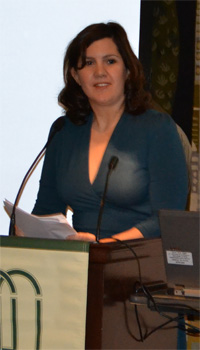Museum curators collect other people’s pants, dresses, coats and hats from historic periods because garments “reveal truths about not just individual lives, but communal values and experiences,” said art historian Kimberly Chrisman-Campbell, who spoke on, “Other People’s Clothes: The Study, Display and Defense of Historic Dress in Museums,” at Malott Commons November 17.
“ Garments act as totems and taboos. Even decades or centuries after they were first worn, they retain their power to impress or intimidate,” Chrisman-Campbell said to an audience of more than 80. “Things like Ku Klux Klan robes and Nazi uniforms are very rarely seen in public precisely because they so powerfully evoke events and emotions that we, as a society, would prefer to forget.”
Garments act as totems and taboos. Even decades or centuries after they were first worn, they retain their power to impress or intimidate,” Chrisman-Campbell said to an audience of more than 80. “Things like Ku Klux Klan robes and Nazi uniforms are very rarely seen in public precisely because they so powerfully evoke events and emotions that we, as a society, would prefer to forget.”
Clothes from historical eras can grow controversial over time, Chrisman-Campbell said.
“Many museums are now reluctant to display fur garments because they offend some visitors, though fur has been an integral element of dress for thousands of years,” said Chrisman-Campbell, who has worked as a research scholar in costume and textiles at the Los Angeles County Museum of Art.
Garments are just as expressive as paintings and other pieces of art and they are finally getting their due, she said.
“Compared to other types of artwork, clothing and textiles are relatively cheap to collect, but are notoriously expensive to store and maintain,” said Chrisman-Campbell, who has also worked at The Huntington Library, Art Collections, and Botanical Gardens. “You can’t just hang them on a wall like a painting. You need a small army of mannequins, couriers, dressers … to build the platforms to which the mannequins must be anchored.”
A tear in a piece of clothing can also give historians insights, she said.
“You’ll never see a mud-splattered Picasso hanging in a museum. With costume, though, the flaws are part of the story. It is often the flaws in a garment – the stain, the smells, the split seams and the runaway sequins – that speak the loudest, poignant records of the lives lived in them,” Chrisman-Campbell concluded.
Chrisman-Campbell spoke at Scripps College at the request of Eric Haskell, professor of French Studies and Humanities. Haskell organized the informative and interesting lecture for the Scripps community.

